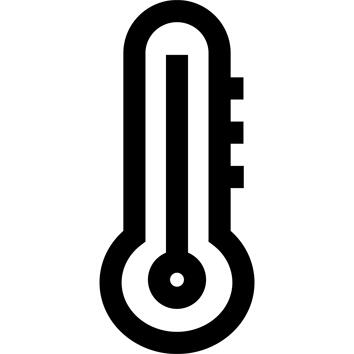Temperature rating:
All our sleeping bags display the temperature ratings, tested by an independent laboratory (AITEX), in accordance with European NF ISO 23537 standard (2017).
The temperature rating is the lower limit at which the user, in a relaxed position, is generally in thermal equilibrium and feels neither cold nor hot (for a standard woman in normal conditions of use).
Choose your sleeping bag accordingly.
What are the temperature ratings?
Limit temperature: temperature at which the user huddled up in the sleeping bag is generally in thermal equilibrium and feels neither too cold nor too hot (defined for a standard man and in normal conditions of use).
Use an insulating mattress for superior thermal insulation.
This sleeping bag is filled with feathers and down. The thermal insulation may drop in damp conditions.
What you need to know about the temperature ratings:
A sleeping bag does not produce heat but retains the heat produced by the body. If you are tired and cold and you slip inside a cold, damp sleeping bag, it is very likely that you will feel cold no matter how good your sleeping bag is! These temperature ratings therefore depend on the person's sensitivity to the cold (bulk, fatigue, etc), equipment (mattress with insulation, etc), clothing (naked, underwear, etc) and weather conditions (humidity, wind, etc).
For greater comfort, before getting into your sleeping bag:
Dress simply (1 layer of clothing is enough).
Keep your head, hands and feet warm: wear hats, gloves and socks, use bed warmers, rubbing, etc.
A water bottle filled with hot water can be used as a hot water bottle (as long as there is no risk of it opening accidentally!)
Contract your muscles (70% of the energy consumed is transformed into heat) without moving as this can cause draughts of cold air.
Use a silk or thermal sleeping bag liner to maximise the warmth and hygiene inside your bag.
Shape:
The mummy shape optimises thermal insulation (no loss of heat because there is not much air flow or draughts) and saves space, which means that your movements are restricted.
Width at the shoulders 72 cm, height at the feet 26 cm in size L.
Ergonomic hood with drawcord.
Double slider, lined with an anti-cold duvet flap, side opening.
H-shaped box-wall baffle construction to reduce thermal bridges.
Weight and size:
Size S 750 g, user height: up to 1.60 m. Folded dimensions: Ø 15 x 34 cm. Volume 6.1 Litres. 380 g of feathers.
Size M 850 g, user height: 1.60 m to 1.70 m. Folded dimensions: Ø 16 x 34 cm. Volume 6.9 Litres. 440 g of feathers.
Size L 985 g, user height: 1.70 to 1.85 m. Folded dimensions: Ø 17 x 34 cm. Volume 7.8 Litres. 500 g of feathers.
Size XL 1050g, user height: 1.85 to 2 m. Folded dimensions: Ø 18 x 34 cm. Volume 8.7 Litres. 560 g of feathers.
Size and thermal insulation:
Try out your bag before buying it to make sure you choose the right size for your comfort.
Ideally, you should not be pressed up against the fabric, at the feet or head, and the fabric should not be taut. This would create thermal bridges that lower the insulation of your sleeping bag. Conversely, a sleeping bag that is too big will be harder to heat up and will not be as good at insulating the heat generated by the body.
Origin of feathers:
Thanks to our traceability system, we can guarantee the origin of the feathers, in compliance with our commitment to use responsibly sourced materials. Our suppliers are committed to using only feathers that come from ducks that are bred for their meat and which are plucked after slaughtering. The feathers and down used for your sleeping bag come from ducks reared in China.
http://developpement-durable.decathlon.com/documents-et-rapports/documents/
Filling:
90% duck down/10% duck feathers.
Filling Power of the down: 800 CUIN (IDFB standard)
Feathers require special care. Follow care advice.
Washing instructions
Turn inside out and machine wash at 30°C on a delicate cycle with 3 or 4 laundry balls (or clean, used tennis balls). Use a special detergent for feathers and down. Rinse several times. Spin dry on a very slow delicate cycle.
Required step: tumble dry on a gentle cycle at low heat. Finish off by air drying, ideally in the sun, on both sides to prevent the down from clumping together.
Dry your sleeping bag thoroughly before storing.
Warranty:
This sleeping bag is guaranteed for 5 years from the date shown on the sales receipt. The product covered by the warranty will be repaired or exchanged free of charge. The warranty covers product defects, excluding those resulting from normal wear and tear and improper use. This special 5-year warranty is only valid on presentation of the product and receipt.
Weight
S : 0.75 kg
M : 0.85 kg
L : 0.945 kg
XL : 1.05 kg













